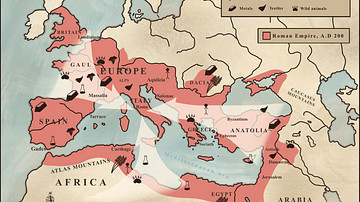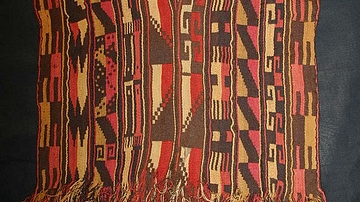Search
Search Results

Definition
Christopher Jones, Captain of the Mayflower
Christopher Jones (l. c. 1570-1622 CE) was the English captain and quarter-owner of the Mayflower, the cargo ship that brought the religious separatists (now known as pilgrims) to the New World in 1620 CE. Little is known of Jones' life prior...

Image
The First Industrial Revolution, c. 1760 - 1840
An illustration depicting the First Industrial Revolution - a time of technological and scientific innovation that led to the rapid industrialization and urbanization of Europe and North America's agricultural economies (the term Industrial...

Image
Trade in the Roman Empire Map (c. 200 CE)
This map shows the major sources of trade goods in the Roman Empire, circa 200 CE. The map shows the sources of the following trade goods: grain, olive oil, slaves, wine, metals, textiles and wild animals.

Image
Wari Tunic
A Wari tunic, Peru, 750-900 CE. The geometrical designs with idosyncratic arrangement is typical of Wari textiles. (George Washington University Museum, The Textile Museum, Washington D.C.)

Image
Nazca Poncho
A Nazca poncho (200 BCE-500 CE) which illustrates the vibrant colours and bold linear patterns typical of Nazca textiles. (Lombards Museum)

Article
Trade in Medieval Europe
Trade and commerce in the medieval world developed to such an extent that even relatively small communities had access to weekly markets and, perhaps a day's travel away, larger but less frequent fairs, where the full range of consumer goods...

Article
Fashion & Dress in Ancient Mesopotamia
Fashion and dress in Mesopotamia – clothing, footwear, and accessories – was not only functional but defined one's social status and developed from a simple loincloth in the Ubaid Period (c. 5000-4100 BCE) to brightly colored robes and dresses...

Article
Women in Ancient Mesopotamia
The lives of women in ancient Mesopotamia cannot be characterized as easily as with other civilizations owing to the different cultures over time. Generally speaking, though, Mesopotamian women had significant rights, could own businesses...

Article
Fall of the East India Company
The British East India Company (1600-1874) was the largest and most successful private enterprise ever created. All-powerful wherever it colonised, the EIC's use of its own private army and increasing territorial control, particularly in...

Article
Trade Unions in the British Industrial Revolution
Trade unions were formed in Britain during the Industrial Revolution (1760-1840) to protect workers from unnecessary risks using dangerous machines, unhealthy working conditions, and excessive hours of work. The trade union movement was vigorously...